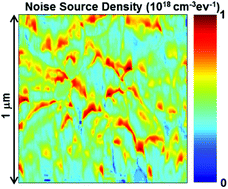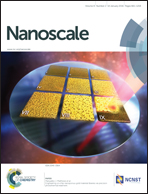Nanoscale direct mapping of localized and induced noise sources on conducting polymer films†
Abstract
The localized noise-sources and those induced by external-stimuli were directly mapped by using a conducting-AFM integrated with a custom-designed noise measurement set-up. In this method, current and noise images of a poly(9,9-dioctylfluorene)-polymer-film on a conducting-substrate were recorded simultaneously, enabling the mapping of the resistivity and noise source density (NT). The polymer-films exhibited separate regions with high or low resistivities, which were attributed to the ordered or disordered phases, respectively. A larger number of noise-sources were observed in the disordered-phase-regions than in the ordered-phase regions, due to structural disordering. Increased bias-voltages on the disordered-phase-regions resulted in increased NT, which is explained by the structural deformation at high bias-voltages. On photo-illumination, the ordered-phase-regions exhibited a rather large increase in the conductivity and NT. Presumably, the illumination released carriers from deep-traps which should work as additional noise-sources. These results show that our methods provide valuable insights into noise-sources and, thus, can be powerful tools for basic research and practical applications of conducting polymer films.


 Please wait while we load your content...
Please wait while we load your content...